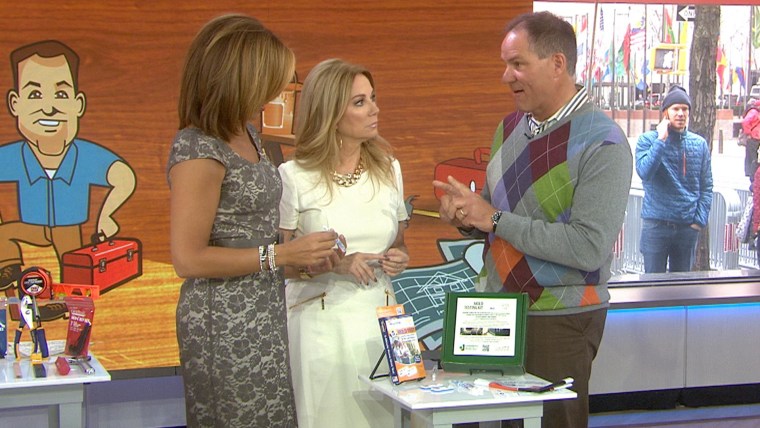How to Get Black Mildew Spots Out of Clothes
Mold and mildew thrive in moist conditions. That means musty-smelling growth can be found just as easily on damp clothing as it can on carpets and upholstered furniture. (Ew!)
To help avoid this situation, TODAY Home asked some cleaning pros about how to get mold out of fabric, how to remove mildew from fabric, how to remove mildew smell and how to get rid of mildew and mold from other surfaces in your home.
Here's their advice on how to remove mold and mildew from:
- White-cotton clothing
- Non-bleachable clothing
- Grout and wall
- Upholstery
- Carpets
How to remove mold and mildew from white-cotton clothing
Olivia Joyce, cleaning pro with Move Out Mates, has two effective strategies for how to get mold out of clothes, depending on the fabric involved.
Bleach is the most effective way to remove mold and mildew from clothing made out of white cotton, Joyce says. Apply a solution of one part bleach to three parts water to the stain and allow the solution to sit for a few minutes, then launder the clothing as usual.
How to remove mold and mildew from non-bleachable clothing
If the article cannot be bleached, try removing the mold with lemon juice or white vinegar. Soak a cotton pad in lemon juice or vinegar and place it on the stain. Allow it to soak for several minutes. Remove the pad and sprinkle the area with some salt to further boost the effect of the acid. If possible, place the item in a sunny spot to dry. The sun rays also bleach stains. Repeat as needed, then launder as usual.
If you've tried to remove mildew from fabric, but the mildew stain persists, bring the article to a professional dry cleaner.
How to remove mold and mildew from grout and walls
To clean mildew and mold effectively from walls and grout, Joyce suggests that you mix a solution of one part bleach to three parts water. Dampen (don't soak) a sponge with the solution and apply it to the moldy areas. (Remember to wear protective gear such as glasses, gloves and even a face mask, advises Joyce.) As the mildew disappears, dry the area using an old towel. The mold itself isn't that hard to clean, but it can get messy if you don't squeeze the excess water from the sponge.

How to remove mold and mildew from upholstery
Jack White, vice president of technical services for Rainbow International, explains what's actually going on when you see mold on your comfy couch.
Mold has to have the right conditions to grow on upholstery. First, there must be an organic food source — mold cannot grow on synthetic materials — but it can grow on the soil embedded in synthetic materials. (A good reason to vacuum the furniture!) There must also be moisture. The organic material has to stay wet for a certain period of time for mold to begin to grow. (Make sure spills are wiped up immediately and that fabric is totally dry before replacing cushions.)
Given this knowledge, here are White's recommendations for dealing with mold on upholstery:
- If your upholstered furniture has water damage and a substantial amount of mold growth, it should be replaced.
- If there's only a small mold stain, you can try using a 3 percent hydrogen peroxide solution. Blot it on the mold and allow it to work for a minute or so. Rinse solution from the area by alternately dabbing it with a damp cloth or sponge and a dry cotton cloth. This probably will not remove the mold, but it may help lessen the stain.
- Consult a professional upholstery cleaner if the stain persists or reappears.
White also adds that silk, wool, antique or vintage upholstery should be cleaned by a professional.
How to remove mold and mildew from carpet
Be very careful dealing with mold, advises Dean Carter, a carpet-cleaning expert. Silk and wool carpet should always be professionally cleaned. Likewise, only a certified mold expert should remove any substantial amount of mold from carpet. However, if it's a very small area, and it's safe to use chlorine bleach on the carpet, you can try this.
- "Do not use bleach without testing an inconspicuous area of the carpet first to make sure of no color loss," cautions Carter. "You can get away with this on some carpets, but not on others. Although some loss of color is still better than mold in the home."
- Clean the carpet using a steam cleaner if possible. If you don't have access to a steam cleaner, scrub the moldy area using a sponge dipped in a mixture of 1 teaspoon liquid dish detergent (I prefer the blue Dawn) and 1 quart of water.
- After the initial surface cleaning is done, mix 1 cup of household bleach (hypochlorite solution) with 1 gallon of water and sponge it directly the affected area. Let the solution sit and soak into the carpet for 10 to 15 minutes.
- Using a steam cleaner (or shop vac), suction up any remaining moisture on the carpet.
- It's important to dry the carpet as much as possible to prevent mold growth. To absorb residual moisture, place a folded towel over the wet area and stand on it. Move to a fresh area of the towel as moisture is absorbed. Be sure to thoroughly wash the towel after you use it.
This story was originally published Jan. 24, 2018.
How to Get Black Mildew Spots Out of Clothes
Source: https://www.today.com/home/how-remove-mold-mildew-anything-everything-t108127#:~:text=Bleach%20is%20the%20most%20effective,launder%20the%20clothing%20as%20usual.